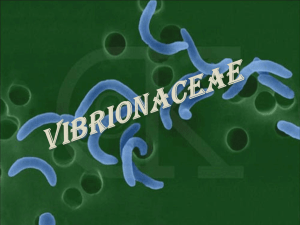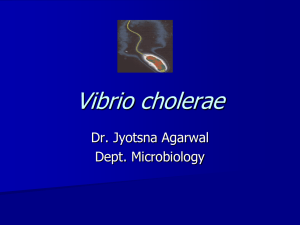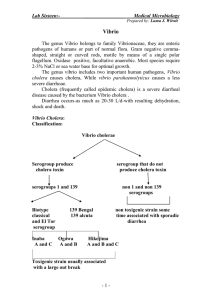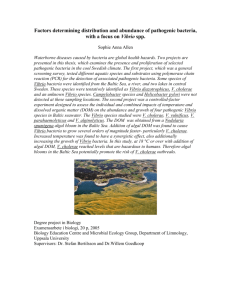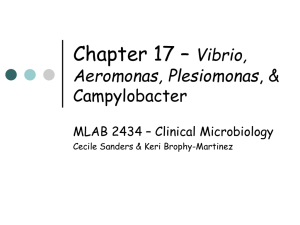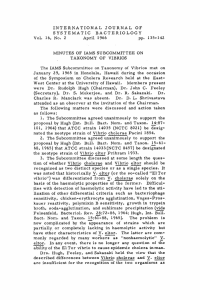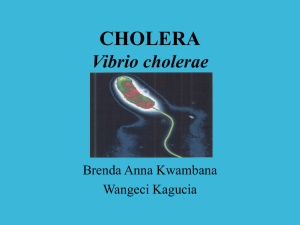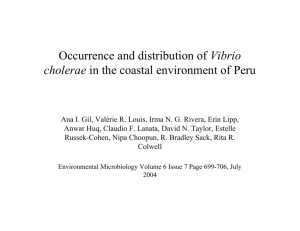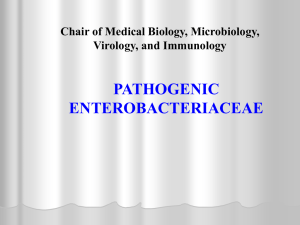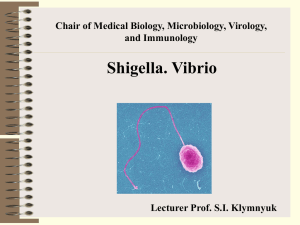Vibrio cholerae
advertisement
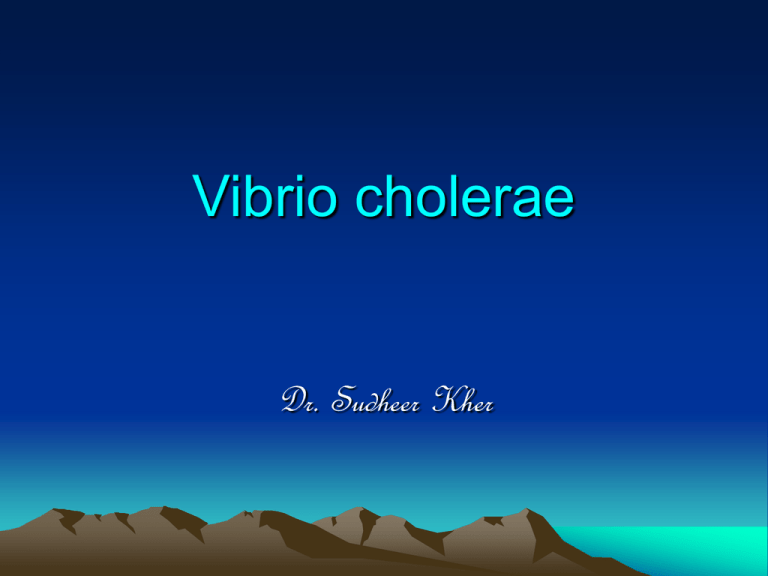
Vibrio cholerae Dr. Sudheer Kher Key Words • • • • • • Vibrio cholerae Late lactose fermenter Oxidase positive String test Hemodigestion Choleragen (cholera toxin) • Rice water stool • Fish in Stream appearance • • • • • • • • Darting motility Cholera red reaction TCBS Transport media Classical Vs El Tor Endemic Severe Dehydration Halophilic vibrios Vibrios • Gram negative, rigid, curved Comma shaped rods, motile by means of a single polar flagellum. • Origin of the term vibrio –> vibrare=vibrate • Nonsporing & noncapsulated. • Present in marine environment and surface water all over the world. • Important member Vibrio cholerae - first observed by Pacini (1854) and first isolated by Robert Koch in Egypt in 1883. • Stained smears from mucus flakes in stool show parallel arrangement called “fish in stream” appearance. • Darting motility by a single polar flagellum describes as “swarm of gnats”. Cultural characteristics • • • • • • Strongly aerobic but can grow anaerobically. Grows at 16-40 C optimum 37 C pH 6.4 – 9.6 optimum 8.2 NaCl is required for growth at 0.5-1% Grows on ordinary culture media Nutrient agar – Moist translucent disc like colonies, 1-2 mm diameter with bluish tinge in transmitted light. Distinct odour present. • MacConkey’s agar – Initially colourless later become pink due to lactose fermentation (late lactose fermenter). Cultural characteristics • Blood agar – Initially surrounded by zone of greening, later the zone is clear due to hemodigestion. • Gelatin stab culture – Infundibuliform liquifaction in 3 days at 22 C. • Peptone water – In six hours fine surface pellicle is formed. Turbidity and powdery deposit later. Special Media for V. cholerae • Holding or Transport media – Venkataraman – Ramakrishnan (VR) medium – 20 g crude sea salt + 5 g peptone in 1 litre of DW. Adjust pH to 8.6-8.8 Dispense in screw capped bottle 10-15 ml 1-3 ml stool added to each bottle. Vibrios do not multiply but remain viable for several weeks. Cary-Blair medium – Buffered solution of Sodium chloride, Sodium thioglycollate. Disodium phosphate and Calcium chloride at pH 8.4 The medium is suitable for Salmonella, Shigella as well as V. cholerae. Enrichment media • Alkaline peptone water at pH 8.6 • Monsur’s taurocholate tellurite peptone water at pH 9.2 • Both these are good transport as well as enrichment media Plating media • Alkaline Bile Salt Agar (BSA) – – pH 8.2, widely used. Colonies like on Nutrient agar. • Monsur’s Gelatin Taurocholate Trypticase Tellurite Agar (GTTA) – – Small translucent colonies with greyish black centre and turbid halo. The colonies become 3-4 mm in 48 hrs. • Thiosulphate Citrate Bile Salt Sucrose (TCBS) medium – – Widely used. Yellow colonies turning green on further incubation. String test • Vibrio colonies identified by string test. Loopful of growth mixed with a drop of Sod. Deoxycholate on a slide. • Positive test indicated by – Loss of turbidity – Mucoid appearance – Formation of ‘string’ as the loop is drawn away from suspension Biochemical reactions • Catalase & Oxisase tests are positive. • Glucose, Mannitol, Maltose, Sucrose fermented with acid production. • Lactose fermented late. • Indole formed & nitrates reduced to nitrites. These two give cholera red reaction. Few drops of Conc. H2SO4 added to 24 hr peptone water culture. Development of reddish pink colour due to production of nitroso-indole indicates presence of V. cholerae. • Methyl Red & urease tests negative. • • • • • • • • • • • Catalase Oxidase G M M S L I MR U Cholera red + + A A A A Late A + _ _ + Resistance • Susceptible to heat, drying & acids. • Can survive for 2-3 days on linen in dry condition. • Survive in tap water for 30 days, cold storage food, for 30 days. • El Tor strains survive better than classical strains • Susceptible to disinfectants including chlorine. Gardener & Venkatraman’s Classification Vibrio Gp A Cholera vibrios Gp B Biochem & Ag heterogenous Biochem similarities; Common H Ag V. cholerae Serogroups O1 Non – 01 Currently 0-139 Classical Ogawa Inaba El Tor Biotypes Hikojima Serotypes Classical Cholera Vs El Tor Vibrio Test Classical cholera El Tor vibrio Hemolysis - + Voges Proskauer - + Chick erythrocyte agglutination - + Polymixin B sensitivity@ + - Group IV phage susceptibility + - El Tor phage V susceptibility - + @ 50 iu disc O serotypes of Cholera vibrios SEROTYPE O ANTIGENS Ogawa AB Inaba AC Hikojima ABC Transmission - V. cholerae feces water – fresh – salt food Cholera toxin (CT) Choleragen • B binds to gangliosides • provides channel for A • A catalyses ADP-ribosylation –regulator complex – activates adenylate cyclase CT determined by chromosomal gene. Each molecule has 1 A & 5 B subunits A – Active B - Binding A1 – Active A2 - Linking B attaches to GM1 ganglioside receptor of eneterocyte Allowing entry of A subunit in enterocyte Splits into A1 & A2 allows only biologically active A1 to be linked with B Prolonged activation of cellular adenylate cyclate and accumulation of cAMP Outpouring of large qty of water + electrolytes + Carbonates + K Diarrhea Cholera disease • Massive fluid and electrolyte loss. Upto 20 litres per day. • Leads to extracellular volume loss, hemoconcentration, hypokalemia, base deficit acidosis, shock. • Leads to Muscular cramps, renal failure, pulmonary edema, cardiac arrhythmias and paralytic ileus. • No fever, no WBCs in stool Brackish water (less commonly brack water) is water that has more salinity than fresh water, but not as much as seawater. Laboratory Diagnosis • Specimen collection – – Stool collected in acute stage before administration of antibiotic – Best collected by No. 26 or 28 rectal catheter – Rectal swabs may be used particularly in convalescent patients. – Grossly – “Rice water stool” – Not suitable • Specimen from pans • Vomitus Transportation • Whenever possible, specimen plated at bedside and inoculated plates sent to the lab. • Preserve at 4 C or in holding medium whenever delay is more than few hours Cary – Blair medium VR fluid If delay is only few hours, transport medium can be used Monsur’s medium Alkaline peptone water If transport media are not available, filter paper strips can be soaked in stool sample, sealed in plastic envelopes and sent to lab. Processing of specimens • Direct microscopy – – Not too reliabile • Rapid diagnosis – – Demonstration of characteristic darting motility coupled with immobilization by specific antiserum. • Enrichment media specimens – – Incubate for 6-8 hrs inclusive of transit time followed by streaking in selective & non-selective media. – Direct plating can also be done before enrichment. – Plating media used • BSA • MacConkey’s • TCBS Processing of specimens • After overnight incubation, suspicious colonies should be tested for Ag detection using antisera. • International reference centre located at National Institute of Cholera & Enteric Diseases (NICED), Calcutta, India. Testing water samples for Vibrios • Enrichment method – – 900 ml water added to 100 ml tenfold concentrated peptone water at pH 9.2, incubated at 37 C for 6-8 hrs. A second enrichment is done before plating on solid media. • Filtration technique – – Filter water through Millipore membrane filter, place it directly over the surface of selective medium Cholera -therapy • massive secretion of ions/water into gut lumen • dehydration and death • therapy – fluid replacement – antibiotic therapy • vaccination – partially effective – not generally used – international travelers Prophylaxis & Treatment • Prophylaxis – Injectable killed vaccine gives 50-60% protection. – Live oral vaccine using Texas star strain under study. • Treatment – – Prompt & adequate replacement of water and electrolytes • Oral or Intravenously • Oral tetracycline reduces period of excretion of vibrio and also fluid requirement. Halophilic vibrios • Have high requirement of salt, natural habitat is sea water, marine life. • Disease producing halophilic vibrios – V. parahemolyticus – V. alginolyticus – V. vulnificus Vibrio parahemolyticus • Raw sea-food • Grows best in high salt • Food poisoning due to sea fish •Out breaks in Japan and other countries Vibrio alginolyticus Associated with eye, ear, wound infection in humans exposed to sea water Vibrio vulnificus 1. Wound infections in humans exposed to sea water 2. Consumption of infected oysters penetration of gut Severe septicemias High mortality Key Words • • • • • • Vibrio cholerae Late lactose fermenter Oxidase positive String test Hemodigestion Choleragen (cholera toxin) • Rice water stool • Fish in Stream appearance • • • • • • • • Darting motility Cholera red reaction TCBS Transport media Classical Vs El Tor Endemic Severe Dehydration Halophilic vibrios
